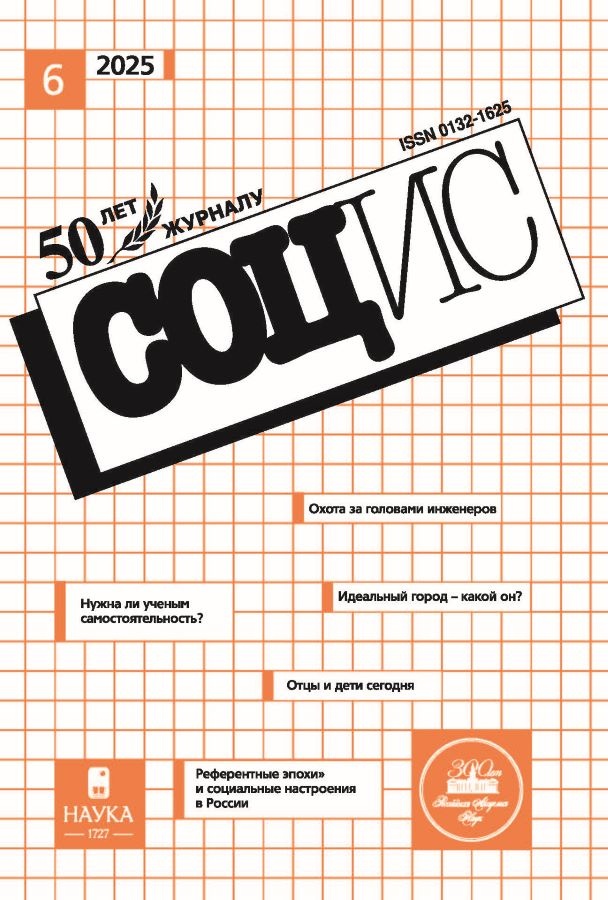On the role of historical eras and symbols in modeling dynamics and shocks of social attitudes in Russia
- Authors: Karacharovskiy V.V.1
-
Affiliations:
- HSE University
- Issue: No 6 (2025)
- Pages: 3-14
- Section: SOCIOLOGY OF MASS COMMUNICATIONS
- URL: https://ter-arkhiv.ru/0132-1625/article/view/690149
- DOI: https://doi.org/10.31857/S0132162525060013
- ID: 690149
Cite item
Abstract
The article evaluates the possibility of forecasting mass social attitudes based on the interest of the population for the eras in the development of the country. Historical eras and their symbols are considered as comparison standards, temporal analogues of reference groups that provide the mass consciousness with samples of “reserve” standards of living and standards of achieved results, as starting points for assessing the degree of satisfaction of the population with the development of the country in the current period. An approach to modeling the dynamics and shocks of the index of the state of affairs in the country (VCIOM index 2018–2025 was used) based on statistics of Internet queries by Russians for data on the eras and/or their symbols that are important for the modern history of Russia is proposed. Basing on it, the nature of the connection between the population’s interest in reference eras and the dynamics of social attitudes in Russia is discussed, and the phenomena of economic and ideological gaps and economic in the dynamics of social attitudes are derived. The contribution of the heroic-patriotic complex of eras and symbols to greater accuracy of forecasting social attitudes is shown in addition to the system of economic factors: interest in the Great Patriotic War, Victory, USSR historical connotations of the concepts “Homeland” and “Superpower”, I. V. Stalin’s name.
Full Text
About the authors
Vladimir V. Karacharovskiy
HSE University
Author for correspondence.
Email: vvk@hse.ru
Russian Federation, Moscow
References
- Андреев А. Л. Национальный хронотоп в поколенческой перспективе // «Стрела времени» в массовом сознании россиян: оценки прошлого, суждения о настоящем, представления о будущем / Под ред. М. К. Горшкова. М.: Весь мир, 2024. C. 255–286. [Andreev A. L. (2024) National chronotope in generational perspective. In: “The arrow of time” in the mass consciousness of Russians: assessments of the past, judgments about the present, ideas about the future. Ed. by M. K. Gorshkov. Moscow: Ves Mir: 255–286. (In Russ.)]
- Карачаровский В. В. Спрос на эпохи // Социологические исследования. 2021. № 3. С. 3–16. doi: 10.31857/S013216250013029–4. [Karacharovsky V. V. (2021) Demand for Epochs. Sotsiologicheskiye issledovaniya [Sociological Studies]. No. 3: 3–16. (In Russ.)]
- Тощенко Ж. Т. Что происходит с исторической памятью о Великой Отечественной войне? // Социологические исследования. 2020. № 5. С. 18–22. doi: 10.31857/S013216250009419-3. [Toshchenko Zh.T. (2020) What is Happening to the Historical Memory of the Great Patriotic War? Sotsiologicheskiye issledovaniya [Sociological Studies]. No. 5: 18–22. (In Russ.)]
- Evans A. B., Jr. (1977) Developed Socialism in Soviet Ideology. Soviet Studies. Vol. 29. No. 3: 409–428. doi: 10.1080/09668137708411136.
- Fabrykant M., Magun V. (2019) Dynamics of National Pride Attitudes in Post-Soviet Russia, 1996–2015. Nationalities Papers. Vol. 47. No. 1: 20–37. doi: 10.1017/nps.2018.18.
- Hoogstrate A. J. (2023) The Effect of Big Data and AI on Forecasting in Defence and Military Applications. In: Towards a Data-Driven Military: A Multidisciplinary Perspective. Ed. by P.B.M.J. Pijpers, M. Voskuijl, R.J.M. Beeres. Leiden: Leiden University Press, 2023: 145–160.
- Matejova M. (2018) Why Was 'Communism Better'? Rethinking Inequality and the Communist Nostalgia in Central Europe. Journal of Comparative Politics. Vol. 11. No. 1: 66–83.
- Nye J. S. (2009) Get Smart: Combining Hard and Soft Power. Foreign Affairs. Vol. 88. No. 4: 160–163.
- Social Theory and Social Structure. (1957) Ed. by R. K. Merton. Revised ed. Glencoe, Illinois: Free Press.
- Varian Hal R., Choi H. (2009) Predicting the Present with Google Trends. April 2. URL: https://ssrn.com/Abstract=1659302 (accessed???). doi: 10.2139/ssrn.1659302.
- Wæver O., Buzan B., Kelstrup M., Lemaître P. (1993) Identity, Migration and the New Security Agenda in Europe. London: Pinter.
- Zweynert J. (2014) ‘Developed Socialism’ and Soviet Economic Thought in the 1970s and Early 1980s. Russian History. Vol. 41. No. 3: 354–372. doi: 10.1163/18763316-04103004.
Supplementary files












